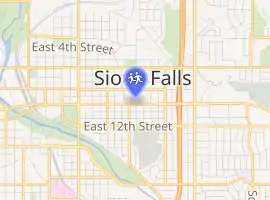South Dakota School for the Deaf
The South Dakota School for the Deaf (SDSD) was a state-supported school located in Sioux Falls, South Dakota that provided services to meet the educational needs of children who are deaf, hard-of-hearing, or have cochlear implants. SDSD is governed by the South Dakota Board of Regents.
| South Dakota School for the Deaf | |
|---|---|
 Former High school building at the South Dakota School for the Deaf | |
| Location | |

| |
2001 East Eighth Street Sioux Falls, South Dakota 57103-1896 | |
| Coordinates | 43°32′50″N 96°42′06″W |
| Information | |
| Type | Public |
| Established | 1880 |
| State Aid | $3,517,946 |
| Website | SDSD's official website |
South Dakota School for the Deaf | |
| Area | 4.5 acres (1.8 ha) |
| Built | 1884 |
| Architect | Wallace L. Dow; John Chapman |
| Architectural style | Romanesque, Collegiate Tudor |
| NRHP reference No. | 81000576[1] |
| Added to NRHP | June 14, 1981 |
SDSD was founded in 1880 as the Dakota Territorial School for Deaf Mutes when the area was still part of the Dakota Territory.[2] When South Dakota became a state in 1889, the school was placed under the state's Board of Charities and Corrections and the name changed to its present form. In 1944, voters ratified an amendment to the state constitution which moved SDSD and the South Dakota School for the Blind (now the South Dakota School for the Blind and Visually Impaired) under the care of the South Dakota Board of Regents.
The student population reached a peak of 100-150 students by the 1960s; advances in hearing aid technology made it possible for hard of hearing students to stay in regular classes and various disability-related laws passed between the 1970s and 1990s led to increased placement of deaf students in public school environments rather than sending them to SDSD. The result was a gradual decline to about 50 students by the mid-1990s. This combined with the prevailing attitude of the Regents towards deafness led to the establishment of the current auditory / oral (cochlear implant) program and later, the transfer of both this and the original sign language-based program to neighboring school districts, leading to the closure of the main campus in 2011. The campus was sold, the remaining functions (administration and outreach) relocated to a building in a commercial area adjacent to a strip joint.
External links
References
- "National Register Information System". National Register of Historic Places. National Park Service. July 9, 2010.
- Gannon, Jack. 1981. Deaf Heritage–A Narrative History of Deaf America, Silver Spring, MD: National Association of the Deaf, p. 47 (PDF Archived 2012-03-28 at the Wayback Machine)